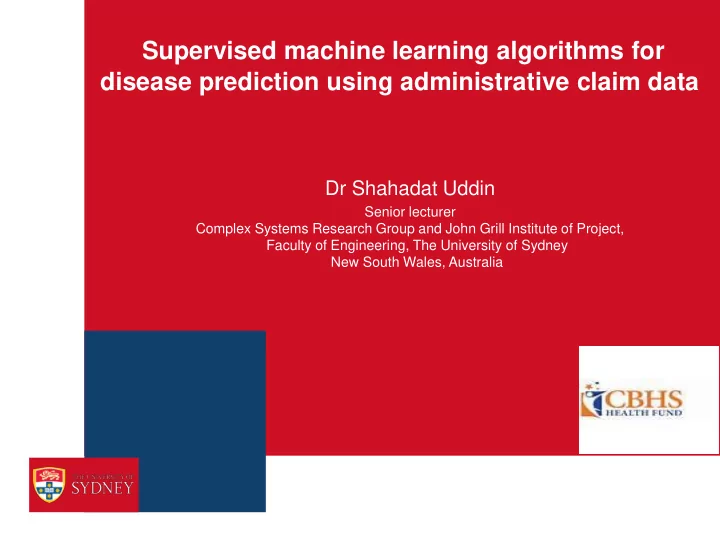

Supervised machine learning algorithms for disease prediction using administrative claim data Dr Shahadat Uddin Senior lecturer Complex Systems Research Group and John Grill Institute of Project, Faculty of Engineering, The University of Sydney New South Wales, Australia
Motivations Supervised machine learning algorithms already gained wide acceptance for developing predictive models in various contexts A large volume of healthcare data has been collected on a regular basis by different healthcare service providers On the other side Chronic diseases are the leading causes of death worldwide. Diabetes is one of the major chronic diseases. About 422 million people worldwide have diabetes (WHO). According to Australian Institute of Health and Welfare (AIHW 2019) – ₋ Diabetes contributes 11% of deaths in 2017 ₋ Type 2 diabetes accounts for over half of all diabetes deaths ₋ An estimates 1.2 million (6%) Australian adults had diabetes in 2017-2018 Diabetes (T2D) could lead to the development of other chronic diseases (e.g. CVD). 2
Related other studies Rule-based scoring models including Charlson Comorbidity Index (Charlson et al., 1987) ₋ to predict the 10-year mortality for a patient. A collaborative filtering method – CARE (Davis et al., 2010 ) ₋ can predict future disease risk. ₋ but it raises many false alarms to predict the future disease risks. Network-based approaches – (Khan et al., 2018) ₋ to understand and represent the progression of T2D using graph analytics. ₋ multiple chronic disease progression is not tested. 3
Research goal Employ supervised machine learning algorithms to develop predictive risk model for type 2 diabetes using only administrative claim data ₋ Logistic regression ₋ Support vector machine ₋ Random forest ₋ K-nearest neighbour ₋ Artificial neural network Tuning of hyperparameter 4
Research methods Data source Administrative claim data provided by CBHS (https://www.cbhs.com.au/) Total patients: 8000 (4000 diabetic and 4000 Non-diabetic) Use ICD codes to extract the records of diabetes patients Overall Diabetic Non-Diabetic Overall 8000 4000 4000 No of patients Male 2618 1751 867 Female 5382 2249 3133 5
Research methods (cont.…) Variable selection S/L Comorbidity S/L Comorbidity 1 Congestive heart failure 16 Lymphoma 2 Cardiac arrhythmias 17 Metastatic cancer 3 Valvular disease 18 Solid tumour without metastasis 4 Pulmonary circulation disorders 19 Rheumatoid arthritis/collagen vascular diseases 5 Peripheral vascular disorders 20 Coagulopathy 6 Hypertension, uncomplicated 21 Obesity 7 Hypertension, complicated 22 Weight loss 8 Paralysis 23 Fluid and electrolyte disorders 9 Other neurological disorders 24 Blood loss anaemia 10 Chronic pulmonary disease 25 Deficiency anaemia 11 Hypothyroidism 26 Alcohol abuse 12 Renal failure 27 Drug abuse 13 Liver disease 28 Psychoses 14 Peptic ulcer disease excluding bleeding 29 Depression 15 AIDS/HIV Comorbidities and health conditions added to Elixhauser index 30 Cataract 33 Macular degeneration 31 Anaemia, unspecified 34 Presence of coronary angioplasty implant and grafts 32 History of long-term medication, insulin 35 Presence of aortocoronary bypass graft A Khan, S Uddin, U Srinivasan, (2019) Chronic Disease Prediction Using Administrative Data and Graph Theory: The Case of Type 2 Diabetes, Expert Systems with Applications 6
Results and Discussion Comparison of performance (10 fold, 80/20 split, python SKlearn package) 𝐵𝑑𝑑𝑣𝑠𝑏𝑑𝑧 = 𝑈𝑄 + 𝑈𝑂 𝑈𝑄 + 𝑈𝑂 = 𝑄 + 𝑂 𝑈𝑄 + 𝑈𝑂 + 𝐺𝑄 + 𝐺𝑂 ML (supervised) algorithms Accuracy (%) Logistic regression 77.56 Support vector machine 76.32 Random forest 81.95 K-nearest neighbour 82.73 Artificial neural network 80.42 7
Results and Discussion (cont …) Tuning k value for KNN (10 fold and 80/20 split) Tuning K of K -nearest neighbour 15.68 15.66 15.64 Error rate (%) 15.62 15.60 15.58 15.56 15.54 15.52 15.50 50 60 70 80 90 100 110 K value KNN improves its accuracy to 84.48% 8
Results and Discussion (cont …) Further insight from KNN (group-wise performance) 𝑈𝑄 𝑈𝑄 2 × 𝑈𝑄 𝑄𝑠𝑓𝑑𝑗𝑡𝑗𝑝𝑜 = 𝑆𝑓𝑑𝑏𝑚𝑚 = 𝐺1 𝑡𝑑𝑝𝑠𝑓 = 𝑈𝑄 + 𝐺𝑄 𝑈𝑄 + 𝐺𝑂 2 × 𝑈𝑄 + 𝐺𝑄 + 𝐺𝑂 Group Precision Recall F1 socre Non-diabetic 0.83 1.00 0.91 Diabetic 1.00 0.00 0.00 9
Results and Discussion (cont …) Further insight from KNN – develop propensity model Propensity model : – predict disease risk with an p value Neighbour statistics is used to develop a propensity model Received the IP rights from USyd of an integrated software tool (Database, SQL and Python) 10
Summary In a nutshell… Apply ML for disease risk prediction by using only administration claim data All variables considered in this study can be extracted from claim data The precision value for the diabetic patients indicates that this approach can be used for designing intervention program. Future study… Similar experiment and study design for – ₋ Other chronic diseases ₋ Comorbidity of multiple chronic diseases 11
References ₋ https://www.aihw.gov.au/reports/diabetes/diabetes-snapshot/contents/how-many-australians-have-diabetes/type-2- diabetes ₋ https://www.who.int/news-room/fact-sheets/detail/diabetes ₋ Charlson, M. E., et al. (1987). "A new method of classifying prognostic comorbidity in longitudinal studies: development and validation." Journal of chronic diseases 40 (5): 373-383. ₋ Davis, D. A., et al. (2010). "Time to CARE: a collaborative engine for practical disease prediction." Data Mining and Knowledge Discovery 20 (3): 388-415. ₋ Khan, A., et al. (2018). "Comorbidity network for chronic disease: A novel approach to understand type 2 diabetes progression." International journal of medical informatics 115 : 1-9. 12
13
Recommend
More recommend